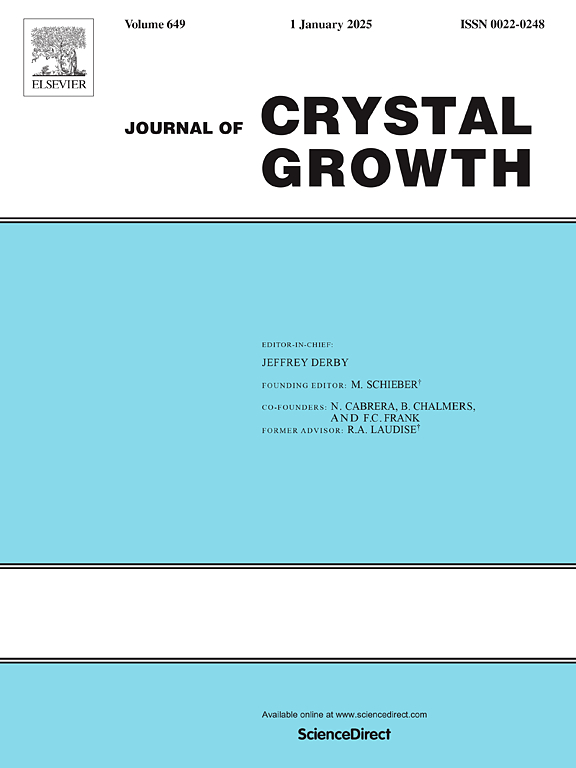Optical and photocatalytic properties of nickel oxide nanoparticles
IF 2
4区 材料科学
Q3 CRYSTALLOGRAPHY
引用次数: 0
Abstract
This study investigates the optical and photocatalytic properties of Nickel Oxide (NiO) nanoparticles synthesized via co-precipitation at 400 °C for 6 h using nickel nitrate hexahydrate and sodium hydroxide. Characterization techniques, including X-ray diffraction (XRD), Fourier Transform Infrared Spectroscopy (FTIR), Scanning Electron Microscopy (SEM), energy dispersive X-ray analysis (EDX), and UV–vis spectroscopy, were employed. XRD confirmed the NiO product with a face-centered cubic structure and a crystallite size of 11.32 nm. FTIR analysis identified functional groups associated with NiO formation. SEM revealed agglomerated nanoparticles of approximately 22.34 nm in size with a spherical shape. The synthesized NiO exhibited a strong UV absorption peak and an optical band gap of 4.39 eV. The synthesized NiO nanoparticles effectively degraded methylene blue under sunlight. The photocatalytic activity was optimized with catalyst dosages of 2 mg, 5 mg, and 10 mg. The 10 mg dose achieved the highest degradation efficiency of 92.32 % in 40 min, while 2 mg and 5 mg also exhibited substantial degradation, achieving rates of 87.08 % and 87.48 %, respectively. A reusability study indicated excellent stability and photocatalytic activity. These findings suggest NiO nanoparticles’ potential for wastewater treatment applications.

氧化镍纳米颗粒的光学和光催化性能
研究了以六水硝酸镍和氢氧化钠为原料,在400℃共沉淀法合成的NiO纳米颗粒的光学和光催化性能。表征技术包括x射线衍射(XRD)、傅里叶变换红外光谱(FTIR)、扫描电子显微镜(SEM)、能量色散x射线分析(EDX)和紫外可见光谱。XRD证实产物为面心立方结构,晶粒尺寸为11.32 nm。FTIR分析鉴定了与NiO形成相关的官能团。扫描电镜显示,纳米颗粒大小约为22.34 nm,呈球形。合成的NiO具有较强的紫外吸收峰和4.39 eV的光学带隙。合成的纳米NiO在日光下能有效降解亚甲基蓝。催化剂用量为2 mg、5 mg和10 mg时,光催化活性最佳。10 mg的降解效率最高,在40 min内达到92.32%,2 mg和5 mg的降解率也相当高,分别达到87.08%和87.48%。可重复使用性研究表明其具有优异的稳定性和光催化活性。这些发现表明了NiO纳米颗粒在废水处理中的应用潜力。
本文章由计算机程序翻译,如有差异,请以英文原文为准。
求助全文
约1分钟内获得全文
求助全文
来源期刊

Journal of Crystal Growth
化学-晶体学
CiteScore
3.60
自引率
11.10%
发文量
373
审稿时长
65 days
期刊介绍:
The journal offers a common reference and publication source for workers engaged in research on the experimental and theoretical aspects of crystal growth and its applications, e.g. in devices. Experimental and theoretical contributions are published in the following fields: theory of nucleation and growth, molecular kinetics and transport phenomena, crystallization in viscous media such as polymers and glasses; crystal growth of metals, minerals, semiconductors, superconductors, magnetics, inorganic, organic and biological substances in bulk or as thin films; molecular beam epitaxy, chemical vapor deposition, growth of III-V and II-VI and other semiconductors; characterization of single crystals by physical and chemical methods; apparatus, instrumentation and techniques for crystal growth, and purification methods; multilayer heterostructures and their characterisation with an emphasis on crystal growth and epitaxial aspects of electronic materials. A special feature of the journal is the periodic inclusion of proceedings of symposia and conferences on relevant aspects of crystal growth.
 求助内容:
求助内容: 应助结果提醒方式:
应助结果提醒方式:


